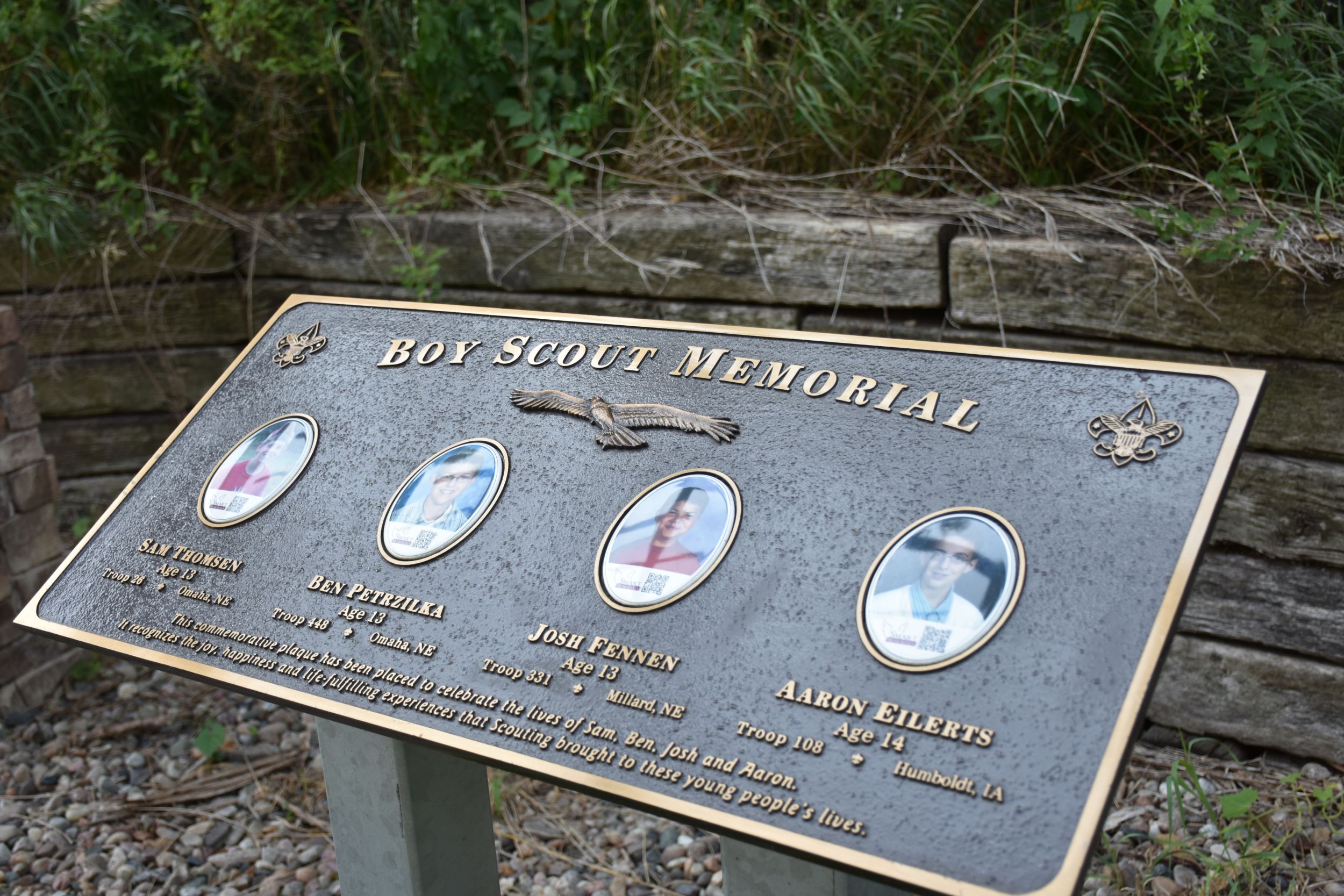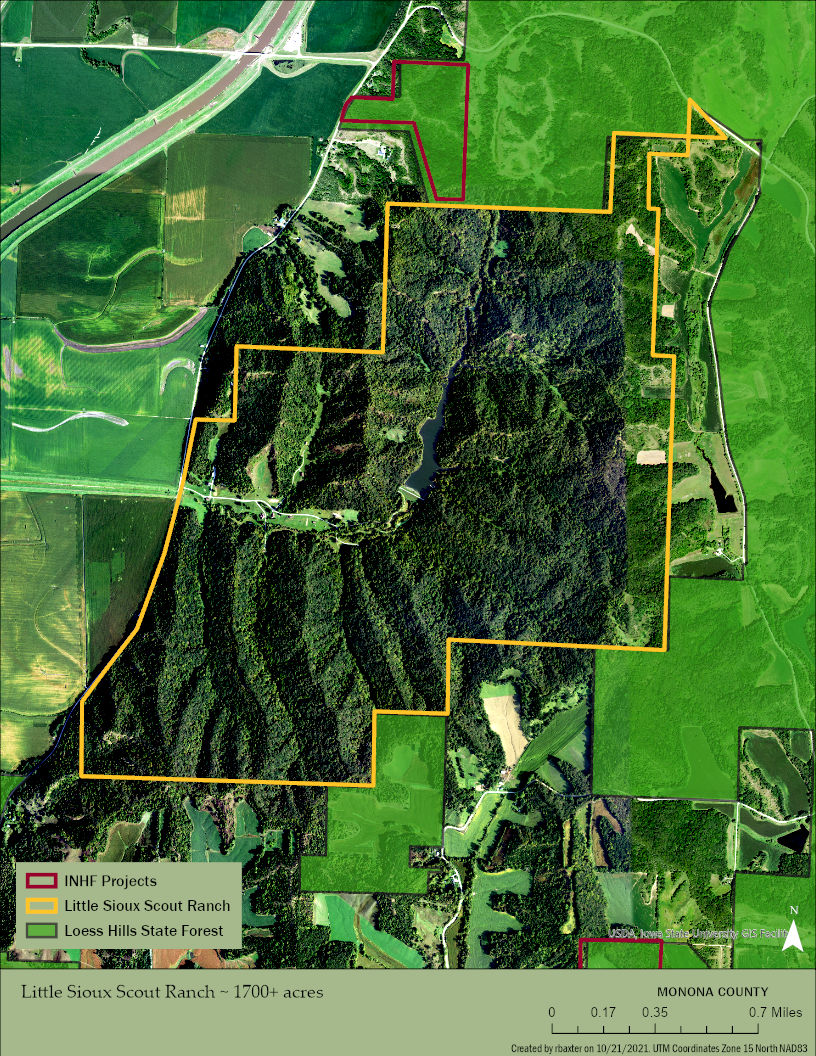Scout's Honor
By Joe Jayjack on September 22, 2022 in Blog
Scouts have spent thousands of nights under the stars at Little Sioux Scout Ranch (LSSR) in western Iowa’s Monona County.
LSSR, spread across the western slope of the Loess Hills, has given scouts a place to hike, canoe, fish — and learn to tie knots — for more than 50 years. At almost 1,800 acres, it is also one of the largest privately owned natural areas in the state, and one of the few that offers this sense of remote wilderness.
Since the early 1970s, LSSR has been the home of Camp Amikaro, where Cub Scouts often get their first taste of camping. It has hosted day camps, overnight wilderness experiences and family camping weekends.
“On an average year, we would get more than 10,000 [individual] nights of camping at Little Sioux,” said Chris Mehaffey, CEO of the Mid-America Council of the Boy Scouts of America (BSA). “Generations of cub scouts have done their camping at Little Sioux. All three of my children have camped there. It’s a very special place for me.”
LSSR has served as a place for scouts to connect with nature and engage in projects that develop a love of service and, according to BSA, “teach children that doing their best can be a fun and rewarding experience — no matter the difficulty of the challenge.”
Sometimes those challenges can seem monumental.
Troubled skies
On June 11, 2008, 96 boys and 24 youth leaders were at LSSR. They all came from the Mid-America Council, which includes western Iowa and parts of Nebraska and South Dakota. The boys had been specially picked for the camp to study leadership skills and wilderness survival.
Shortly after dinner that evening, a pounding storm developed into a tornado. Winds reaching 165 mph tore through the camp, snapping trees and flattening buildings, including the lodge where most of the scouts had taken shelter. Four boys — Aaron Eilerts, 14, of Eagle Grove, along with Josh Fennen, 13, Sam Thomsen, 13, and Ben Petrzilka, 14, all of Omaha — were killed when the chimney of the lodge collapsed.
Four dozen others were injured, and the scouts immediately used their first aid training to help each other while waiting for emergency responders to arrive. It was the beginning of a long recovery for the camp and all the people that were there.
 The camp was re-opened the following May, and a memorial to the four boys was erected. Later that year, the New York Says Thank You Foundation and Mid-America Council coordinated hundreds of volunteers to help build an open air chapel on the foundation of the site where the four scouts died, using reclaimed timber from the camp and surrounding areas.
The camp was re-opened the following May, and a memorial to the four boys was erected. Later that year, the New York Says Thank You Foundation and Mid-America Council coordinated hundreds of volunteers to help build an open air chapel on the foundation of the site where the four scouts died, using reclaimed timber from the camp and surrounding areas.
Things settled into a new normal at LSSR, with scouts returning to camp, connecting with nature and learning new skills. But attendance at the camp was steadily declining, a trend that has been happening with camps across the country.
The Gillwell Foundation, which owns all the properties used by the Mid-America Council, began a years-long study of all of its camps, looking at usage and determining the best future for each property. In 2021, they came to the difficult decision that they would sell Little Sioux Scout Ranch. Ideally, they would find a buyer who could do three things:
- Open the property to the public
- Maintain the memorial to the four boys that died in the 2008 tornado
- Honor and share the history of LSSR as a scout camp
They immediately reached out to Iowa Natural Heritage Foundation.
A new partnership
“From the very first phone call when I called [INHF President] Joe McGovern and told him what we’d like to do, he was very interested,” Mehaffey said. “I had two or three other individuals that were interested in pieces right away. But we wanted to keep it whole and make sure it would be available to the public.”
In the fall of 2021, INHF purchased an option to buy property with the help of multiple donor funds designated for Loess Hills land protection. The option must be exercised by Dec. 31, 2022, in order to secure the property as a whole. The project will cost more than $7 million in total, and INHF has set a goal to raise at least $2 million privately by the end of the year.
“We believe the history of the property, especially the memorial to the lives of the boys that were lost in 2008, is very important to preserve as part of this land,” McGovern said. “INHF has worked in the Loess Hills for decades. We know this land is special, and we’re grateful for the opportunity to preserve the Little Sioux Scout Ranch.”
 What makes this land so special? First is its size. The average privately owned parcel of land in the Loess Hills is around 100 acres. At almost 1,800 acres, LSSR offers unsurpassed opportunities for outdoor recreation such as hiking, birdwatching, wilderness camping, fishing and hunting. The property has 25 miles of established trails and a 20-acre lake with some of the best fishing in western Iowa, according to Mehaffey.
What makes this land so special? First is its size. The average privately owned parcel of land in the Loess Hills is around 100 acres. At almost 1,800 acres, LSSR offers unsurpassed opportunities for outdoor recreation such as hiking, birdwatching, wilderness camping, fishing and hunting. The property has 25 miles of established trails and a 20-acre lake with some of the best fishing in western Iowa, according to Mehaffey.
Once secured, INHF will work with partners to open the property to the public and expand use around the Loess Hills State Forest, which is owned and managed by the Iowa DNR.
Next is the land itself. LSSR, which is about halfway between Council Bluffs and Sioux City, is mostly old-growth oak woodland and remnant prairie on the western bluffs of the Loess Hills, a globally unique area consisting of ridges formed by wind-blown soil.
“This landscape at this scale only exists in two places in the world, here and along the Yellow River in China,” said INHF Loess Hills Land Stewardship Director Kody Wohlers, who noted that even within the Hills, this expanse of historical woodland is rare. “To be able to protect a piece of this size, and what that means for wildlife habitat and outdoor recreation, is a once-in-a-lifetime opportunity.”
LSSR is in a state-designated Bird Conservation Area, making it a haven for birdwatching, one of North America’s fastest growing outdoor activities. It is also in a National Park Service-designated Special Landscape Area and lies along the Loess Hills National Scenic Byway.
Gaining momentum
The project has already garnered support from community partners. The Iowa West Foundation has awarded a $500,000 grant to INHF to go toward the purchase of the property, recognizing its potential to benefit western Iowa residents and the importance of maintaining the memorial.
Brenda Mainwaring, president and CEO of the Iowa West Foundation, had a colleague whose son was killed in the 2008 tornado at LSSR. “I remember very vividly the impact that had on him and his family. Opening this property to the public broadens the ability for people to go and pay their respects and honor the boys who were killed there,” she said.
The Gilchrist Foundation, based in Sioux City, awarded a $150,000 grant to the project, with the pledge of another $150,000 if INHF exercises the option to purchase the property by the end of the year. That leaves at least $1.2 million for INHF to raise by the end of the year to reach its fundraising goal.
“The early support for this project has been amazing,” said Abby Hade Terpstra, INHF Director of Philanthropy. “We’re so grateful for these lead gifts from the Iowa West Foundation and the Gilchrist Foundation. And now we’re excited to engage with people that hold special memories of this place and people that are excited to explore it for the first time.”
The project is likely to take 3-5 years for INHF to complete, and in that time they will lease the camp back to the Mid-America Council for use and management. Even after the property is completely opened to the public, Mehaffey envisions scouts continuing to use it for years to come.
“I can see Eagle Scout projects being done for generations at Little Sioux. Arbor Day can be celebrated by planting native trees. Scouting will continue to have a presence there,” Mehaffey said. “When parents want to take their kids back to where they did scouting, they’ll be able to do that. It will be the same place, the same topography. There are a ton of people here that know of Little Sioux because of the tornado, but there’s not a whole lot of them that have been there. Now they’ll be able to go and get to know this place.”
If you're inspired to support the LSSR project, give today